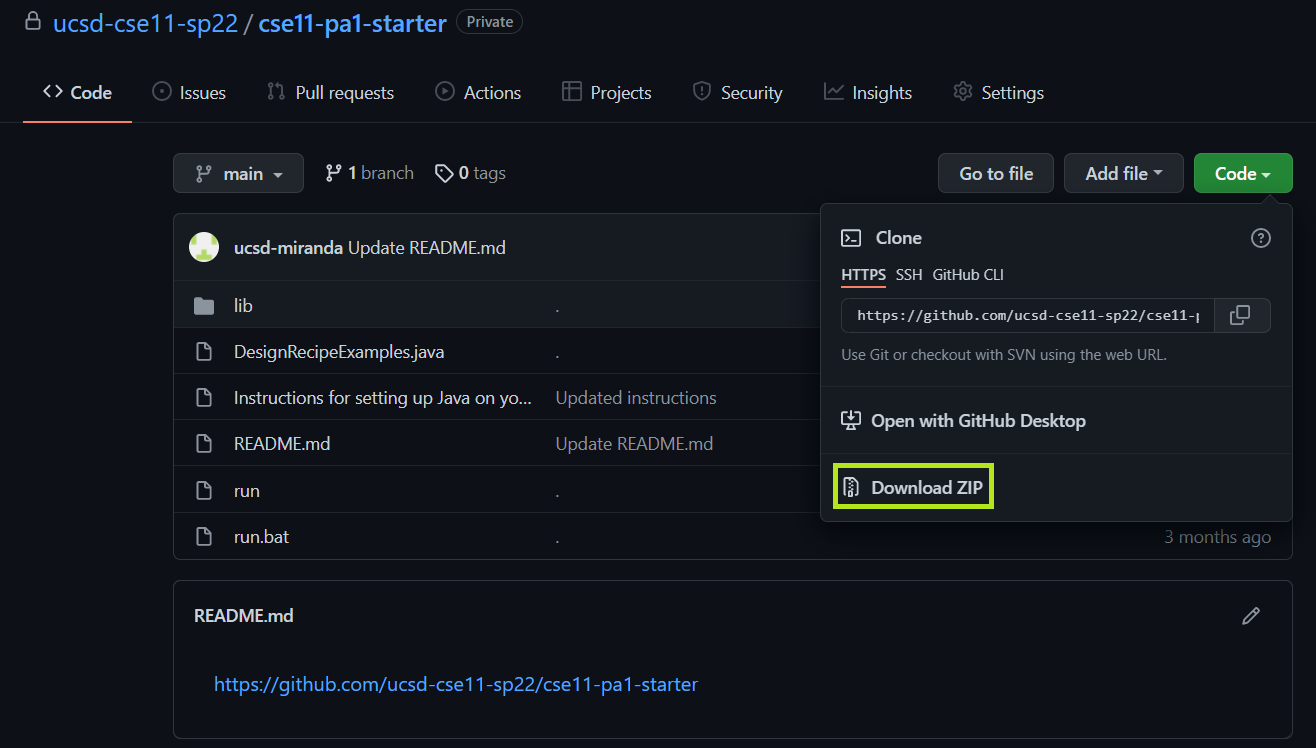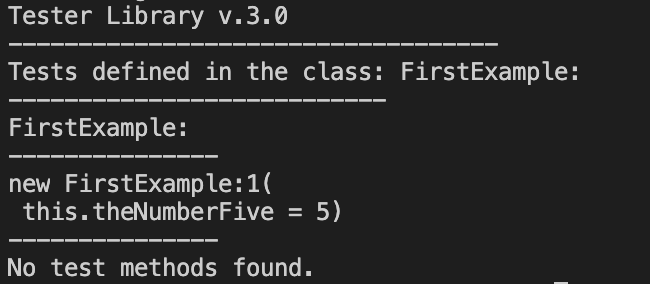CSE 11 Programming Assignment 1
Due Date: Tuesday, April 5, 10:00PM Pacific Time
Learning Goals
- Set up and test your Java development environment
- Write functions that take integer parameters and return integer results.
- Practice using design recipes
FAQs
Permission denied issue while trying to run lecture code (Mac/Linux)
If you are working on Mac or Linux machines and you want to run the lecture code (or PA1) by using the run script, you might encounter an error that says
-bash: ./run: Permission denied
To solve this issue, run the following command first:
chmod +x run
before running the command ./run FirstExample.
Collaboration
Different assignments in this course have different collaboration policies.
On this assignment, you can collaborate with anyone in the course, including sharing code. Feel free to offer help to other students, converse about the *assignment, and so on.
In your submission, give credit to all students and course staff who helped you with this assignment by noting their name and how you used their ideas or work. Note that using someone’s work without giving credit to them is a violation of academic integrity.
Submission Checklist
Here is a list of items to check for before submitting PA1.
- DesignRecipeExamples.java
- Perimeter Method
- At least 2 tests, each with different parameters and a comment (at least 2) with the expected value of the test
- BorderArea Method
- At least 2 tests, each with different parameters and a comment (at least 2) with the expected value of the test
- Converter Method
- At least 2 tests, each with different parameters and a comment (At least 2) with the expected value of the test
- 1 comment describing what the converter does, what parameters it takes, and any relevant outside sources
- Combiner Method
- At least 2 tests, each with different parameters and a comment (at least 2) with the expected value of the test
- At least 1 test with parameters that produce an incorrect output and a comment explaining why the output is incorrect OR 1 comment describing why all parameters will produce the correct output
- 1 comment describing what the combiner does, what parameters it takes, and any relevant sources.
- Perimeter Method
- transcript.txt
- Converter method output using the
runcommand with at least 2 tests - Combiner method output using the
runcommand with at least 2 tests
- Converter method output using the
Part 1 - Setting Up
- On your own computer: General instructions for setting up your environment can be found in this document. There are specific video tutorials for Windows and Mac.
- In the CSE Labs: Watch and follow the instructions from this video: this video. In text form, the instructions are:
- If the lab computer is showing a Windows deskto or login, restart it and choose CentOS (first option) on the screen you get when it starts up.
- Locate your CSE11 account, which you can find using the ACMS account lookup tool: https://sdacs.ucsd.edu/~icc/index.php. The username starts with “cs11sp22”. You will need to do an initial password reset, which you only need to do once. It may take up to 20 minutes for the new password to be effective.
- Once you are logged in, you can follow the instructions for using Visual Studio Code to get fully set up
If you get stuck at any point, do any one of the following:
- Take a screenshot and ask on Piazza! (Not sure how to take a screenshot? Try Googling it for your particular platform, like “screenshot microsoft windows” or “screenshot chromebook” or “screenshot os x”, or ask how on Piazza and we can help.)
- Ask for help!
Running Code
Download the starter code for this assignment by downloading this repository using the “Download ZIP” button: https://github.com/ucsd-cse11-sp22/cse11-pa1-starter

Unzip the directory you downloaded, and open it in Visual Studio Code.
You will be creating a simple program from scratch by following the following steps.
-
Create a new file named
FirstExample.java. -
Create a new class named
FirstExample -
Create a new field of type
intnamedtheNumberFiveand assign it the value of5
After completing these steps, you should have something similar to the following piece of code.
class FirstExample {
int theNumberFive = 5;
}
Open the terminal, then run your program using ./run FirstExample (Mac, Lab)
or .\run.bat FirstExample (Windows). You should see output similar to the following.

Let’s explore this program a little. We see that the code is encased inside class FirstExample { ... }. This means that we have created a new class using the class keyword and named it FirstExample. The { and } denote the beginning and end of the FirstExample class. Code we write will be contined inside classes. Classes in Java can contain many different types of information, two of which we will be focusing on in Part 2. They are Fields and Methods. The program we just wrote contains just one field.
Fields are named variables that belong to a class and are written outside of Methods. The class FirstExample contains a single field of type int named theNumberFive with an assigned value of 5. Notice the line int theNumberFive = 5; and how it takes the form of [Type] [Variable Name] = [Assigned Value];. Additionally notice that it belongs to the class FirstExample and not to any method.
By using the run command, we are able to confirm several aspects of our program. We are able to identify our class via the line new FirstExample:1( ... ). The FirstExample class contains 1 field named theNumberFive and its value is 5. We can use the run command to check that our program is working as you expect it to.
Part 2 - Writing Methods
-
You will write your code in DesignRecipeExamples.java. You can run the code to test it yourself with:
Mac and Lab:
./run DesignRecipeExamplesWindows:
.\run.bat DesignRecipeExamples - For problem 3 and 4, you will use the following design recipe:
- Write the method header
- Write a short comment documenting the method (including assumptions, like if a parameter should take values only in a certain range)
- Write examples of calling the method
- Write the method body
Using this recipe for problems 1 and 2 is optional, but highly encouraged.
-
For problems 1 - 4, you will also write tests to ensure the correctness of your code.
To write a test, you will call the written method and assign it to a field that you create. When running your program using the
runcommand, check to see if the actual output matches what you expect from the console.For problems 3 and 4, you will be creating a new file called
transcript.txtand copy/pasting test output from theruncommand into it. See problems 3 and 4 for more details.
(Several of these examples are borrowed from How to Design Programs, and its Supplemental Material)
Problem 1: Perimeter
Develop a method named perimeter that when given an integer width and integer height of a rectangle will return its perimeter.
The rubric we will use to grade this method is:
- The method has a correct header (parameters and return type)
- The method has a correct method body
- There are at least two examples of calling the method with different arguments, commented with their expected values
Problem 2: Border Area
Develop a method named borderArea that given 2 integers, width and height, describing a rectangle, and another 2 integers, width and height, describing a rectangle cut out of the center of the other, returns the area of the region between them. For example, the blue area in this shape:

- The method has a correct header (parameters and return type)
- The method has a correct method body
- There are at least two examples of calling the method with different arguments, commented with their expected values
Problem 3: Converter
Implementation
Develop a method (with a name of your choice!) that takes one int parameter, converts it to another int value, and returns the new int value. For example, your function could convert:
- Fahrenheit to Celsius
- Between currencies
Write a comment for your method, describing what it does and what parameter it takes. If you use any outside sources for the conversion, be sure to cite those in the comment as well.
Testing
Call your method on at least 2 different examples. Compare each result against a reference converter (Many search engines have built-in converters, or you can use a calculator) and add a comment above the function call to discuss differences (if any) that you get between your program and the reference.
- The method has a correct header (parameters and return type)
- The method has a method body that matches the examples you chose
- There are at least two examples of calling the method with different arguments, commented with their expected values
- In the file
transcript.txt, show your program running and the expected values are produced by copy/pasting from the terminal. - You can justify the output based on an external source or your own design description
Problem 4: Combiner
Implementation
Develop a method (with a name of your choice!) that takes at least two int parameters, combines them to another int value, and returns the new int value. For example, your function could combine:
- Feet and inches into total in inches
- Starting hour and minute and end hour and minute into total number of minutes
Write a comment for your method, describing what it does and what parameters it takes. If you use any outside sources, be sure to cite those in the comment as well.
Testing
Call your method on at least 2 different examples. Can you call your method with arguments that run, but produce an incorrect output? Call your method with at least one such pair of arguments, and add a comment above it explaining why the output is incorrect. If you cannot find such a pair of arguments, write a comment explaining why you believe no such input exists.
- The method has a correct header (parameters and return type)
- The method has a method body that matches the examples you chose
- There are at least two examples of calling the method with different arguments, commented with their expected values
- In the file
transcript.txt, show your program running and the expected values are produced by copy/pasting from the terminal. - You can justify the output based on an external source or your own design description
Submission
Your submission will include the following:
- A code submission of your program with the methods you wrote for part two, at PA1 gradescope assignment. You should select and upload the files
DesignRecipeExamples.javaandtranscript.txt
A more detailed list of requirements can be found here
Grading
There are multiple oppurtunities to get feedback for PA1. By submitting before the deadline, you will receive feedback after it is graded shortly after the dealine. You may also submit to the Late/Resubmit for PA1 up to 3 times after the deadline to earn additional feedback.
For more information about the grading policy, visit the course syllabus.
 Schedule
Schedule Calendar
Calendar Syllabus
Syllabus Questions
Questions Material
Material Assignments
Assignments Help Hours
Help Hours